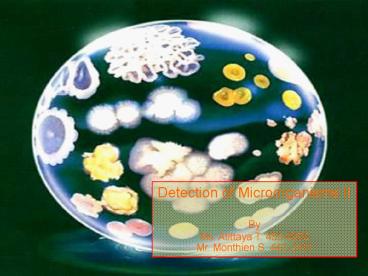Detection of Microorganisms II - PowerPoint PPT Presentation
1 / 21
Title:
Detection of Microorganisms II
Description:
It is the method of choice for determining fecal coliform densities. Disadvantages ... in testing the presence of coliforms? - The most-probable number method ... – PowerPoint PPT presentation
Number of Views:114
Avg rating:3.0/5.0
Title: Detection of Microorganisms II
1
Detection of Microorganisms II By Ms. Atittaya
T. 452-8203 Mr. Monthien S. 442-2411
2
Detection
- 4 Basic methods used for total numbers are
- Standard Plate Counts (SPC) for viable cells
- The most-probable numbers (MPN) for viable cells
(statistical determination) - Dye-reduction techniques for viable cells that
posses reducing capacities - Direct Microscopic Counts (DMC) for both viable
and nonviable cells
3
Alternative Plating Techniques
- Spiral Plating
- ? Using Spiral plater
- - Continuously distributes the liquid inoculum
on the surface of a rotating agar plate - - Results in depositing the sample in an
Archimedes spiral - - After inoculation colonies will grow
intensively near the center of the plate while
fewer grow toward the edge - - Approved by Association of Official Analytical
Chemists (AOAC)
4
Spiral Plating
5
Spiral Plating
- Advantages
- - Less agar is used
- - Fewer plates and pipettes are required
- - Little training is required for its operation
- Disadvantages
- - Food particles may block the dispensing stylus
- - It is more suitable for use of liquid food
- - It is expensive
6
Membrane Filters
- Membranes with a pore size will retain bacteria
(generally 0.45 ?m) - Then the membrane is placed on an agar plate
- Collected microorganisms are viewed and counted
- Suitable for samples that contain low numbers of
bacteria - Example of membrane filters is Hydrophobic Grid
Membrane Filter (HGMF)
7
(No Transcript)
8
(No Transcript)
9
Membrane Filter
- Advantage
- More than 100ml samples can be tested.
- Effective and acceptable technique. Used to
monitor drinking water in government
laboratories. - one of a few methods that will allow the
isolation and enumeration of microorganisms.
10
HGMF
- Advanced by Sharpe and Michaud
- Widely used to enumerate microorganisms from a
variety of food products - 1,600 wax grids on a single membrane filter
(hydrophobic wall to prevent the spread of
colony) - Can detect as few as 10 cells/g
- Can be used to enumerate all cfus including
indicator organisms - Approved by AOAC for total coliforms, fecal
coliforms, and salmonellae
11
The Most-Probable Number
- Presumptive test
- Determine by gas produced
- Confirmed test
- Streak on EMB agar plate
- -Completed test
- Tranferring to lactose broth and NA slant
12
The Most-Probable Number
13
The Most-Probable Number
- Advantages
- It is relatively simple
- Results from one laboratory are more likely than
SPC results to agree with those from another
laboratory - Specific groups of microbes can be determined by
use of appropriate selective and differential
media - It is the method of choice for determining fecal
coliform densities
- Disadvantages
- Large amount of glassware is required
- The lack of opportunity to observe the colonial
morphology of the organisms - Its lack of precision
14
Dye Reduction
- Estimate the number of viable organisms in
suitable products - Methylene blue and resazurin
- Add prepared supernatants of food to standard
solution - Methylene blue blue ? white
- Resazurin blue ? pink or white
- Time used is inversely proportional to the number
of organisms in the sample - A long history of use in the dairy industry,
especially to measure microbial quality from raw
milk
15
Dye Reduction
- Advantages
- Simple, rapid, and inexpensive
- Only viable cells actively reduce the dyes
- Disadvantages
- Not all organisms reduce the dyes equally
- Not applicable to food specimens that contain
reductive enzymes
16
Direct Microscopic Count
- Smears of food specimens or cultures onto a
microscope slide - Stain with an appropriate dyes
- View and count cells with the aid of microscope
- Widely used in dairy industry
17
(No Transcript)
18
Direct Microscopic Count
- Advantages
- It is rapid and simple
- Cell morphology can be determined
- Fluorescent probes for improved efficiency
- Disadvantages
- Results depends on each analyst
- Both viable and nonviable are counted
- Food particles are not always distinguishable
from microorganisms - Some cell may not take the stain well
19
Questions ??
20
Questions ??
- What is the method used for determining both
viable and nonviable cells? - - Direct microscopic count
- Which method is popular in testing the presence
of coliforms? - - The most-probable number method
- What is the relationship between time used and
number of microorganisms in dye reduction method? - - Inversely proportional
21
THANK YOU































